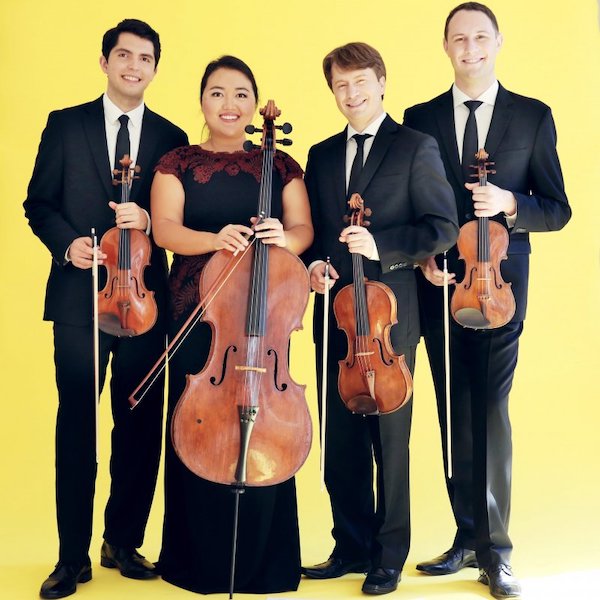Calidore Quartet marks Beethoven year at Pickman Hall

Musicians worldwide are marking the 250th anniversary of Beethoven’s birth by performing even more of his works than usual. Beethoven’s music has never required a special occasion, so this semiquincentennial seems like more of a reflection on how his work continues to move and even surprise us.
Wednesday night, the Calidore String Quartet illustrated the great composer’s depth of form and feeling simply by pairing the Grosse Fugue and the String Quartet in F major (Op. 59, no. 1): a jarring, pre-Romantic—for some, even proto-serialist—work written two years before his death, and a quartet from twenty years earlier cheerfully embracing and shredding conventions.
Calidore’s concert at Longy’s Pickman Hall, presented by the Celebrity Series of Boston, was part of the group’s worldwide Beethoven cycle tour. Celebrating its own tenth anniversary this season, the quartet plays everything from foundational repertoire to contemporary commissions.
That “Grand Fugue” was famously termed confusing and cacophonous when it premiered as part of Beethoven’s Quartet No. 13 in B flat major (Op. 130). This mammoth contrapuntal journey, with its claustrophobic chords, jagged textures and sheer technical difficulty can startle even 21st-century ears.
Calidore swerved into each of Beethoven’s many modulations with impressive unity. Yet once they arrived in new harmonic territory, the four voices didn’t always hang together; a dense blend and booming volume also sacrificed transparency. The group showed more flexibility in the close imitations toward the middle of the piece. By the trilling dialogs and the repeated scherzo, they regained cohesion.
Co-commissioned by the Celebrity Series and Music Accord, Anna Clyne’s Breathing Statues was itself by several of Beethoven’s works, including the Grosse Fugue. As well as Rainer Maria Rilke’s poem “On Music,” from which the title comes.
Second violinist Ryan Meehan introduced the work by noting that the score directs musicians to breathe naturally to find their own entrances. This description elicited some polite laughter, but Calidore’s performance illustrated how literally and effectively they took these markings. The piece’s frequent stops and starts might have turned tedious if not for Calidore’s seamless phrasing.
The English composer’s fifteen-minute single movement mined a lot of sound from the four players: desiccated close harmonies unfolding into lush open chords, hushed paper-thin phrases, tense Middle Eastern-flavored ritornellos, and Romantic cantabile episodes. Clyne’s references to Beethoven’s Grosse Fugue emerged less as blatant quotes and more like spontaneous interpolations into her own ideas.
Breathing Statues was also an opportunity to savor the playing of the individual Calidore players. First violinist Jeffrey Myers revealed a passionate yet balanced lead here, and second violinist Meehan and violist Jeremy Berry almost seemed to trade sonorities in their solos, with the viola pitched in the extreme upper register and the violin in its alto range. Cellist Estelle Choi’s bent pitches toyed with expectations of dissonance while otherwise displaying mellifluous tone.
After intermission, the concert was devoted to Beethoven’s “Rasumovsky” quartet. This was the first quartet in a set of three Beethoven wrote for the eponymous Russian ambassador to Vienna. The work also inaugurated Beethoven’s middle period, when he devoted serious attention to longer quartets while still retaining plenty of humor and Viennese refinement.
Beginning with an earnestly spacious melody in the cello and then violin over a treadmill of eighth notes, Calidore started the Allegro in a fleet yet coherent reading. Their cultivated tone, spry execution, and luminous textures further highlighted Beethoven’s roots in the Classical period. The rhythmic repeated note phrase in the following Allegretto vivace e sempre scherzando built into a conversation that literally had the audience laughing out loud.
The Russian folk song in the closing Allegro proceeded in merry jaunts before splintering into fragments and runs. Deconstructions like these let Beethoven test the boundaries of traditional form and harmony. Calidore’s synthesis of elegance and edginess gave Beethoven’s lengthy explorations a touch of youthful innocence.
Oddly, the Adagio molto e mesto was a disappointment with soft entrances, monochromatic dynamics, and an overall preciosity that made this “very slow and sad” music merely thick and static.
The evening’s encore, the Cavatina from String Quartet No. 13 (the Grosse Fugue’s original home) was a far better fit. The four musicians passed the melodic material between one another with just the right amount of tension and vibrant legato.
Celebrity Series of Boston presents guitarist Miloš with string players from 12 ensemble in a program of Bach, Granados, Piazzolla, and The Beatles 8 p.m. Friday at Jordan Hall. celebrityseries.org; 617-482-2595
Posted in Performances




